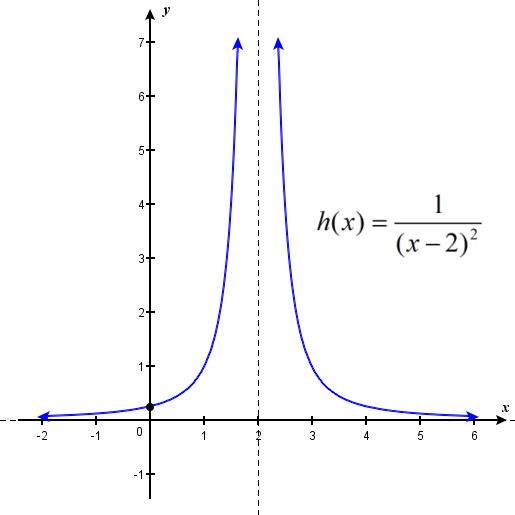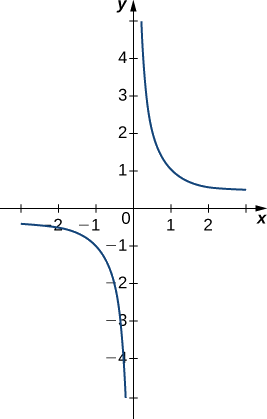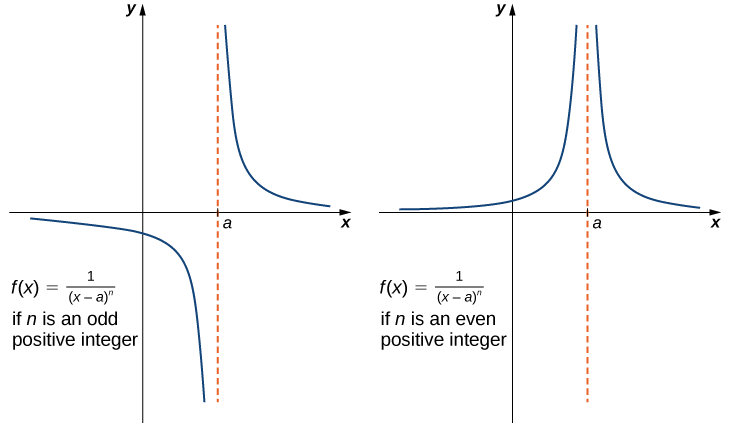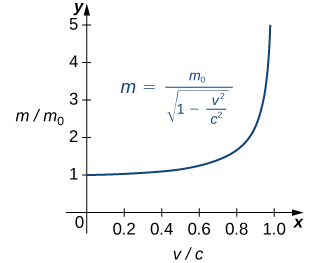2.4: Infinite Limits
- Last updated
- Mar 16, 2023
- Save as PDF
- Page ID
- 123872
( \newcommand{\kernel}{\mathrm{null}\,}\)
Learning Objectives
- Using correct notation, describe an infinite limit.
- Define a vertical asymptote.
Let's continue our exploration of limits by considering the graph of the function
shown in Figure

Infinite Limits
Evaluating the limit of a function at a point or evaluating the limit of a function from the right and left at a point helps us to characterize the behavior of a function around a given value. As we shall see, we can also describe the behavior of functions that do not have finite limits.
We now turn our attention to
More generally, we define infinite limits as follows:
Definitions: Infinite Limits
We define three types of infinite limits.
Infinite limits from the left: Let
i. If the values of
ii. If the values of
Infinite limits from the right: Let
i. If the values of
ii. If the values of
Two-sided infinite limit: Let
i. If the values of
ii. If the values of
It is important to understand that when we write statements such as
Example
Evaluate each of the following limits, if possible. Use a table of functional values and graph
Solution
Begin by constructing a table of functional values.
| -0.1 | -10 | 0.1 | 10 |
| -0.01 | -100 | 0.01 | 100 |
| -0.001 | -1000 | 0.001 | 1000 |
| -0.0001 | -10,000 | 0.0001 | 10,000 |
| -0.00001 | -100,000 | 0.00001 | 100,000 |
| -0.000001 | -1,000,000 | 0.000001 | 1,000,000 |
a. The values of
b. The values of
c. Since
The graph of

Exercise
Evaluate each of the following limits, if possible. Use a table of functional values and graph

Infinite Limits from Positive Integer Exponents on Denominator of a Rational Function
If
If
and
We should also point out that in the graphs of
Definition: Vertical Asymptotes
Let
Exercise
Evaluate each of the following limits. Identify any vertical asymptotes of the function
- Answer a
-
- Answer b
-
- Answer c
-
In the next example we put our knowledge of various types of limits to use to analyze the behavior of a function at several different points.
Example
Use the graph of
![The graph of a function f(x) described by the above limits and values. There is a smooth curve for values below x=-2; at (-2, 3), there is an open circle. There is a smooth curve between (-2, 1] with a closed circle at (1,6). There is an open circle at (1,3), and a smooth curve stretching from there down asymptotically to negative infinity along x=3. The function also curves asymptotically along x=3 on the other side, also stretching to negative infinity. The function then changes concavity in the first quadrant around y=4.5 and continues up.](https://math.libretexts.org/@api/deki/files/7969/imageedit_30_9857663504.png?revision=1)
Solution
Using the definitions above and the graph for reference, we arrive at the following values:
Example
In the Chapter opener we mentioned briefly how Albert Einstein showed that a limit exists to how fast any object can travel. Given Einstein’s equation for the mass of a moving object
what is the value of this bound?

Solution
Our starting point is Einstein’s equation for the mass of a moving object,
where

We can see that as the ratio of speeds approaches 1—that is, as the speed of the object approaches the speed of light—the ratio of masses increases without bound. In other words, the function has a vertical asymptote at
| 0.99 | 0.1411 | 7.089 |
| 0.999 | 0.0447 | 22.37 |
| 0.9999 | 0.0141 | 70.7 |
Thus, according to Table
Key Concepts
- A table of values or graph may be used to estimate a limit.
- We may use limits to describe infinite behavior of a function at a point.
Key Equations
- Infinite Limits from the Left
- Infinite Limits from the Right
- Two-Sided Infinite Limits
Glossary
- infinite limit
- A function has an infinite limit at a point
- vertical asymptote
- A function has a vertical asymptote at
Contributors and Attributions
Gilbert Strang (MIT) and Edwin “Jed” Herman (Harvey Mudd) with many contributing authors. This content by OpenStax is licensed with a CC-BY-SA-NC 4.0 license. Download for free at http://cnx.org.


Follow the procedures from Example
a.
b.
c.
It is useful to point out that functions of the form